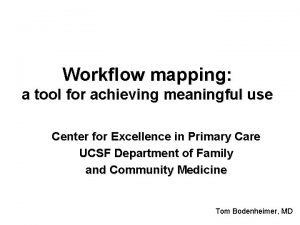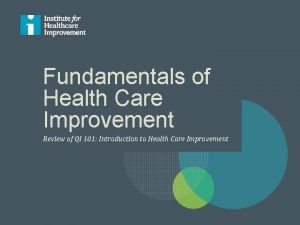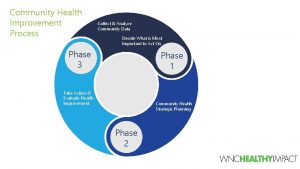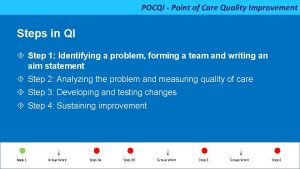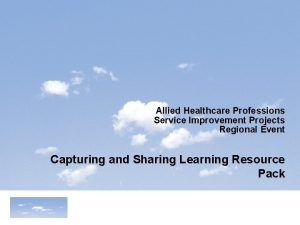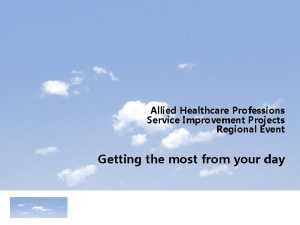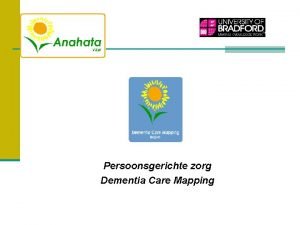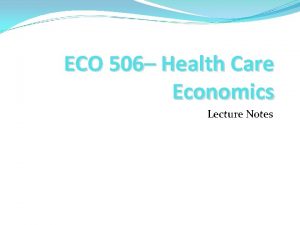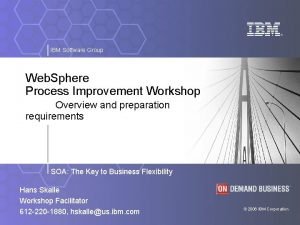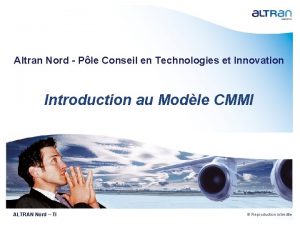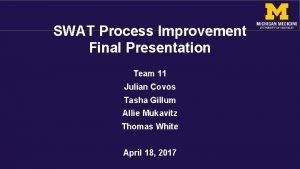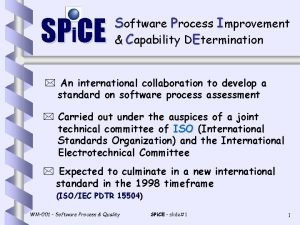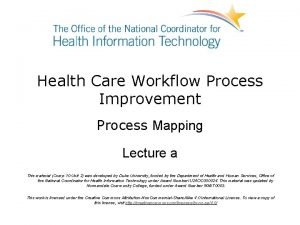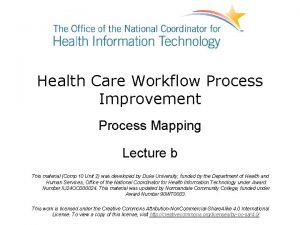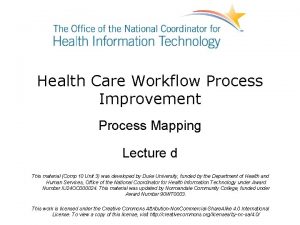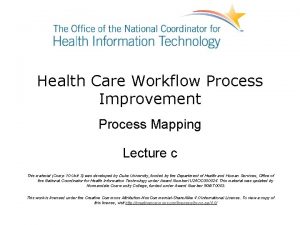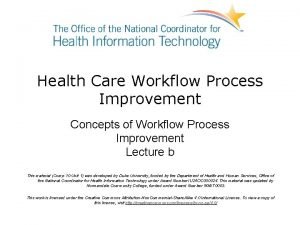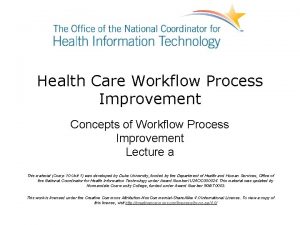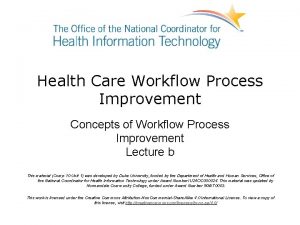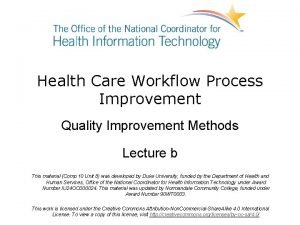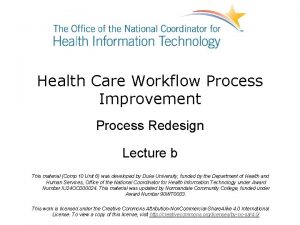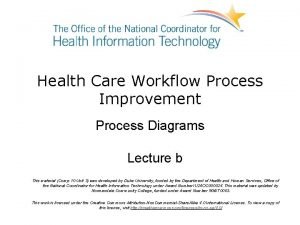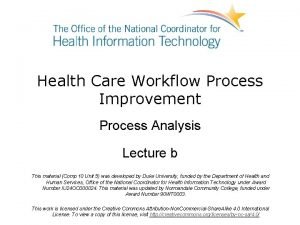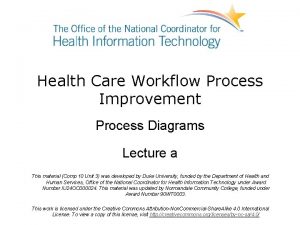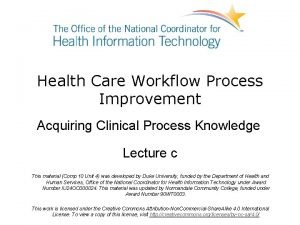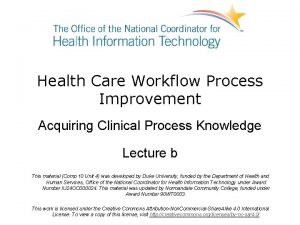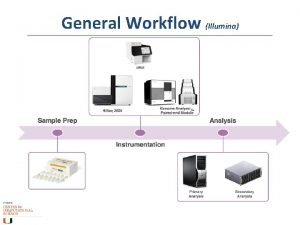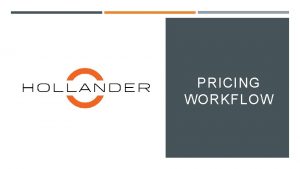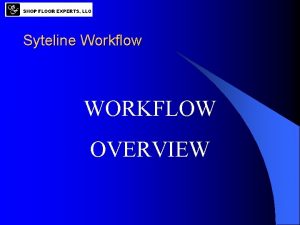Health Care Workflow Process Improvement Process Mapping Lecture





















- Slides: 21

Health Care Workflow Process Improvement Process Mapping Lecture f This material (Comp 10 Unit 3) was developed by Duke University, funded by the Department of Health and Human Services, Office of the National Coordinator for Health Information Technology under Award Number IU 24 OC 000024. This material was updated by Normandale Community College, funded under Award Number 90 WT 0003. This work is licensed under the Creative Commons Attribution-Non. Commercial-Share. Alike 4. 0 International License. To view a copy of this license, visit http: //creativecommons. org/licenses/by-nc-sa/4. 0/

Process Mapping Learning Objectives • Read and interpret UML class, activity, and state diagrams 2

Process Mapping Topics - Lecture f • Purpose, symbols, and conventions for UML – Class, – Activity and – State machine diagram • Reading and interpreting the diagrams 3

Methods for Diagramming Processes Table 3. 5 Methods for Diagramming Processes. Nahm, M. , 2012. 4

Background • Developed by the Object Management Group (OMG) • First version, UML 1 released in 1997 • Created to overcome incompatibility of different notations for software modeling – i. e. , For software design and development, NOT workflow or process representation. • Adapts and incorporates pre-existing notations: – Flowcharts, Yourdon, Gane-Sarson, Entity- relationship diagrams and ISO 5807. 5

Use • Developed for visual modeling in software development • Later to automate software development • 13 different diagrams for representing aspects of computer software – Functionality, data content, and data movement – Not physical process steps • Many IT professionals are trained in UML • Workflow analysts may encounter UML diagrams 6

UML 2. 0 Diagrams Covered • Structure Diagrams – Class Diagram • Behavior Diagrams – Activity Diagram – State Machine Diagram • Interaction Diagrams 7

Class Diagram • Model of the information stored in a system • Analogous to the E-R diagram 8

Class Diagram Example 9

Class Diagram Notation • Classes are shown by boxes • Associations are shown by lines • Cardinality and modality are shown by numbers on the lines 10

Class Diagram - Larger View 11

Activity Diagram • Similar to a flowchart • Shows movement • Uses fewer symbols than flowcharts 12

Activity Diagram Symbols • Activities are shown by a long rectangle with rounded corners • Motion and direction are shown by lines with arrow heads • Branch points are shown by either diamonds or heavy horizontal lines • • • Symbols that have a meaning Start of a process is shown by a solid circle End of a process is shown by a solid circle concentric with a “no fill” circle 13

Activity Diagram Example Patient calls for appointment Receptionist answers Scheduled Office visit occurs 14

State Diagram • Shows the different “statuses” allowed • Valid transitions from state to state 15

State Diagram Symbols • Rectangles that show the states • Lines and arrows that show valid transitions from state to state 16

State Diagram Example open tentative scheduled arrived missed complete 17

Maintenance • UML is an international standard and is maintained by the OMG • The standard is freely available from the OMG web site 18

Process Mapping Lecture f - Summary • Purpose, symbols, and conventions for UML – Class, – Activity and – State machine diagram • Reading and interpreting the diagrams 19

Process Mapping References – Lecture f References Watson, A. (n. d. ). Visual Modelling: past, present and future. Retrieved from UML Website Charts, Tables, Figures 3. 5 Table: Methods for diagramming processes. Nahm, M. , Duke University, 2012. Images Slide 9: Class Diagram Example. Nahm, M. , Duke University, 2012. Slide 10: Class Diagram Notation. Nahm, M. , Duke University, 2012. Slide 11: Class Diagram – Larger View. Nahm, M. , Duke University, 2012. Slide 13: Activity Diagram Symbols. Nahm, M. , Duke University, 2012. Slide 14: Activity Diagram Example. Nahm, M. , Duke University, 2012. Slide 16: State Diagram Symbols. Nahm, M. , Duke University, 2012. Slide 17: State Diagram Example. Nahm, M. , Duke University, 2012. 20

Process Mapping Lecture f This material was developed by Duke University, funded by the Department of Health and Human Services, Office of the National Coordinator for Health Information Technology under Award Number IU 24 OC 000024. This material was updated by Normandale Community College, funded under Award Number 90 WT 0003. 21
 Workflow process mapping for ehr implementation
Workflow process mapping for ehr implementation Qi 101: introduction to health care improvement
Qi 101: introduction to health care improvement Community health improvement process
Community health improvement process Wnchi
Wnchi 01:640:244 lecture notes - lecture 15: plat, idah, farad
01:640:244 lecture notes - lecture 15: plat, idah, farad Primary care secondary care tertiary care
Primary care secondary care tertiary care The associative mapping is costlier than direct mapping.
The associative mapping is costlier than direct mapping. Forward mapping vs backward mapping
Forward mapping vs backward mapping Terjemahan
Terjemahan Health and social care unit 2
Health and social care unit 2 Health and social care component 3 health and wellbeing
Health and social care component 3 health and wellbeing Pocqi
Pocqi Ohio state health assessment
Ohio state health assessment The allied health profession service improvement project
The allied health profession service improvement project The allied health profession service improvement project
The allied health profession service improvement project Dementia care mapping checklist
Dementia care mapping checklist Uphcp
Uphcp Health economics lecture notes
Health economics lecture notes Process improvement workshop examples
Process improvement workshop examples Altran nord
Altran nord Swat process improvement
Swat process improvement Spi in software engineering
Spi in software engineering
